Author's Posts
.webp)
How an LED Lighting Importer Turned Financial Chaos into a System with Finmap
Is financial chaos hindering growth? Finmap brings back control and transparency.
At a certain stage of growth, a successful business faces a critical choice: to remain at the level of intuitive management or to move to a systematic approach.
This is especially true for finances, where every mistake can be costly. A company that has been in the LED lighting and illumination business for 16 years found itself at just such a turning point. They needed to do more than just keep accounts; they needed to see the full financial picture, learn to model the future, and prepare for European standards.
We decided to build a financial model — the pillars of financial reporting: P&L, Cash Flow, Balance Sheet — to see the whole picture of our ecosystem. — Alexander Kravchuk, Chief Financial Officer of an LED lighting import company
What You Will Learn From This Article
In this case study, we will examine how a company in the LED lighting market began its transformation from entrepreneurial chaos to systematic financial management:
- What problems the business faced before making this decision;
- how they found Finmap experts and why they chose the financial model;
- what insights they gained during the implementation phase;
- how the vision of the business changes when a transparent financial system appears;
- what advice the company gives to other entrepreneurs who are hesitant about implementing financial tools.
About the Client's Company
The company is an importer of LED lighting and backlighting with a 16-year history; it operates at the intersection of B2B/B2C and sees lighting as an emotional tool for space, not just a technical product.
The business is entering a phase where scale requires a system: instead of "heroism" — regulations, instead of assumptions — numbers, instead of "no one's" tasks — specific responsibilities.
During this time, the company has grown from a small entrepreneurial project into a powerful business with its own ecosystem of areas of focus. However, with growth came the typical challenges of a mature company: it is difficult to see the full picture of finances, decisions are often made "on intuition," and new areas of focus require clear calculations.
There are now many of us, and we are currently in a phase of transformation. Based on the Adizes model, we are somewhere between an entrepreneurial company and a systemic one. — Oleksandr Kravchuk, Chief Financial Officer
It was at this point that the team realized that further development required a financial system that provided transparency and manageability. The goal was not just to "count profits," but to see the full financial picture of the company: where the funds come from, where they go, which areas are really profitable, and how to plan the next steps.
We urgently need to track financial flows. We are transitioning to European legislation. We need to understand our capitalization and our value so that we can be evaluated. — Oleksandr Kravchuk, Chief Financial Officer
Why Is This Necessary for Business
- To create a systematic financial model with clear pillars: P&L, Cash Flow, and Balance Sheet.
- To prepare for the transition to European accounting standards, which require transparency and regularity.
- Calculate new business directions in advance through unit economics and scenario modeling.
- To identify the person responsible for finance — the "pillar" of the process that maintains financial discipline.
The company did not simply decide to "create a financial model," but laid the foundation for systematic management. For growing businesses, this is always a turning point: it is here that the ability to not only earn money, but also to understand one's own value, capitalization, and potential for scaling is formed.
Difficulties and a Turning Point
The company grew to a point where its scale began to require a system. Intuition and "manual math" no longer yielded results — rules of the game, accountability, and reliable figures were needed to make decisions.
What Hurt in Practice
- Finances without a complete picture. P&L, cash flow, and balance sheet reports are not consolidated into a single model → it is difficult to see the company's "ecosystem."
- Risky scaling. We wanted to open new areas, but without unit economics and scenario modeling, this threatened mistakes and losses.
- Regulatory pressure. The transition to European legislation required transparency, regularity, and standardization of data.
- Blurred responsibility. Without an "owner" of the process, finances stalled — decisions were made slowly, and data was collected unevenly.
We want to move forward and explore new areas. And in order to avoid making certain mistakes, we decided that it was time for a business model. — Oleksandr Kravchuk, Chief Financial Officer
How the Decision Was Made
The need to implement a financial model had been on the radar for a long time, but the conscious transition began in the fall. Then there were about nine months of action: internal discussions, understanding the risks, and searching for an approach.
We wanted to implement a financial model quite a long time ago. It happened last fall, and we worked toward it for nine whole months. — Oleksandr Kravchuk, Chief Financial Officer
Events that triggered systemic changes:
- Expertise of the Finmap financier. The team saw a practical approach to financial management in a sprint.
- "Pillar of responsibility." We brought in a CFO so that one person could track the model and data on a daily basis.
- The decision to build a financial model. Launching work on P&L, Cash Flow, and Balance Sheet as a basis for forecasts and scenarios.
We entered the sprint and saw the Finmap financier. Then we already had a CFO. And with the emergence of the pillar of responsibility, we decided that we could apply the financial model. — Alexander Kravchuk, Chief Financial Officer
This turning point is not about "pretty tables" but about decision-making: when each next step is confirmed by a model, not by the hope that "somehow it will work out."
Searching for a Solution and Collaborating With Finmap
When the team finally realized that it was risky to move forward without a systematic financial model, they began to look for a solution. The task was clear: not just to get a table or a tool, but to build a financial foundation for the business — a model that would show what was happening inside the company, provide forecasts, and help make informed decisions.
How They Found an Expert
The decisive moment came when the team participated in a finance management sprint, where Alexander became acquainted with Kateryna Suprun's expertise. It was then that they realized they needed not just consulting, but the deep involvement of a specialist who would build a model based on the company's real processes.
Finmap offered a format that met the key needs:
- development of a financial model with three main reports — P&L, Cash Flow, Balance Sheet;
- systematic data logic — when all indicators are combined into a single ecosystem;
- involvement of a CFO as a "pillar of responsibility" who keeps processes running on a daily basis.
How the Collaboration Went
The work was done entirely online, with clear security rules, deadlines, and scheduled meetings. This became a separate insight for the team — the quality of service does not depend on the format.
At the first meeting, we discussed security and who owned the resources, and we agreed. Subsequent meetings were held without delays. The service was top-notch. The quality online was the same as offline. — Alexander Kravchuk, Chief Financial Officer
In fact, the company has built a new financial cycle:
- regular financial meetings with updates on key indicators;
- standardized data collection processes;
- a single reporting format where all departments work with the same figures.
The ultimate goal of this collaboration is not just to create a model, but to make finance a manageable element of growth rather than a pain point.
Changes That Have Taken Place During the Collaboration
Although the project is still in progress, the company has already achieved tangible results in the organization of finances, data transparency, and the quality of management decisions.
The financier highlighted the aspects we need to pay attention to. He allowed us to look at the financial history from different angles. We came to understand how to collect unit economics. — Alexander Kravchuk, Chief Financial Officer
1) Visibility of weaknesses → priority actions
- Was: intuitive suspicions about "where it hurts."
- Now: a specific list of risk areas with priorities for elimination (what we are doing now/in the next sprint).
2) Unified logic of data and reports
- Was: fragments in different tables.
- Now: a model framework with three pillars (P&L, Cash Flow, Balance Sheet) and agreed rules for collection/reconciliation.
3) Understanding unit economics
- Was: overall margin without details.
- Now: a clear approach to "how to collect" units, which drivers to count, how to make decisions at the SKU/channel level.
4) "Pillar of responsibility"
- Was: blurred role, financial tasks "hanging in the air."
- Now: the CFO tracks data and models on a daily basis.
5) Quality of service and process (online)
- Was: doubts about the remote format.
- Now: agreed security, clear meetings without delays; quality is not inferior to offline.
In my opinion, 10 out of 10! Finmap service is top notch. — Oleksandr Kravchuk, Chief Financial Officer
Transformation of the Financial System
Advice for Entrepreneurs
This is a concise set of practices that stem from the team's experience and can be applied to your business right now.
1. Assign a "responsibility pillar" before you start
Without an internal owner (CFO/controller), the financial model becomes nothing more than a pretty file. The owner is responsible for collection, reconciliation, updating, and regularity.
2. Start with a minimum scope v0
- Three reports: P&L, Cash Flow, Balance Sheet (12-month history).
- 10–15 drivers (price, conversion, average check, cost, payment terms, exchange rate, etc.) with designated responsible parties.
- 3 scenarios: base/growth/stress.
- Weekly financial rhythm: brief review of actual vs. planned and adjustment of assumptions.
3. Formalize data and security rules
At the first meeting, record: who owns the artifacts, where the model is located who has access, how backups are made, and what SLAs are in place for updates.
4. Measure usefulness, not the "beauty" of reports
Key metrics of system maturity:
- response time to "what if?" (hours → minutes);
- model update frequency (times/week minimum);
- accuracy of forecasts vs. actuals;
- percentage of decisions made based on the model.
5. Don't scale chaos — count units before growth
Launch a new direction/SKU only after calculating the margin, sensitivity to price/exchange rate/payment terms, and testing in three scenarios.
6. Use "feedback outside the technical specifications"
Ask an expert about weak areas, even if they are not included in the basic list of tasks — this is often where the main value lies.
7. Online = offline in terms of quality — if there is a process
Set a schedule for meetings, deadlines, and responsibilities. Discipline makes remote collaboration no less effective.
These steps do not require ideal conditions — just management decisions and discipline. This is where controlled growth begins.
Frequently Asked Questions
1. How long does it take to implement a financial model in an average business?
It depends on the size of the company and the quality of the data. In this case, it took about three months from the start of the sprint to the first working version of the model (P&L, Cash Flow, Balance Sheet). If the data is chaotic, it can take up to six months to prepare.
2. Who should be responsible for the financial model?
The key is the "pillar of responsibility." In this case, it was the CFO, who tracks data daily, checks reports, and is responsible for regular updates. Without such a role, the model does not "live" — it turns into a useless file.
3. Can a financial model be implemented remotely?
Yes. The online collaboration format works just as effectively as offline if security rules, deadlines, and communication format are defined from day one. In the case study, the company worked completely remotely — without delays and with high-quality processes.
4. What are the first results that can be seen after launching the model?
Even at the creation stage, the model provided insights into the weaknesses of the business, allowed us to review financial flows from different angles, and begin to form a unit economy. This is not just "reporting," but a new level of business vision.
5. Where should an entrepreneur who wants to systematize their finances start?
Step by step:
- Appoint a person in charge (CFO/controller).
- Determine the minimum set of financial reports—P&L, Cash Flow, Balance Sheet.
- Collect key drivers (10–15 indicators that affect profit).
- Start with a baseline scenario, then add "optimistic" and "stress" scenarios.
- Set the frequency of financial meetings (weekly or biweekly).
A financial model is the owner's "coordinate system": it shows where the business is going and at what cost.
.webp)
Accounting and Financial Management: What Is the Difference and Why Both Are Important
The difference between accounting and management accounting and their impact on your business. Comparison of the functions, goals and use of each type of accounting for effective financial management and strategic decision-making
Do you really know what's going on with your finances? "I have an accountant, so everything is fine with my finances" — this sounds logical, but only at first glance. The real question is: what kind of data do you use to make decisions about pricing, investments, business growth, or cutting certain areas?
Figures from official accounting reports prepared under NAS (National Accounting Standards) or IFRS are often not timely or detailed enough for day-to-day management tasks. Relying solely on them is like managing your business with your hands tied.
In this article, we’ll break down the real difference between accounting and financial management, why the latter is absolutely essential for any business — and how it helps entrepreneurs gain clarity, control, and confidence in their finances.
Accounting Is Done Mainly for the Government
Accounting is about formality and compliance. Its main purpose is to prove that your business plays by the rules: pays taxes properly, keeps records, submits reports to the tax authorities and other regulators.
What does accounting show?
- What your company owns (assets).
- How much it earns and spends (income and expenses).
- What it owes and to whom (liabilities).
This is the language of the state. That’s why everything here must strictly follow regulations: formats, deadlines, and legal terminology. For you as the owner, this data often holds only technical value.
How Financial Management Works for Your Profit
Financial management is the language of business. It’s created not for the government but for you, and it shows only the numbers that help you manage effectively, increase profits, and avoid financial losses.
What does financial management show?
Want to know which projects are profitable and which are draining resources? Which markup actually works? Which department generates revenue, and which burns the budget? All of this is shown through financial management.
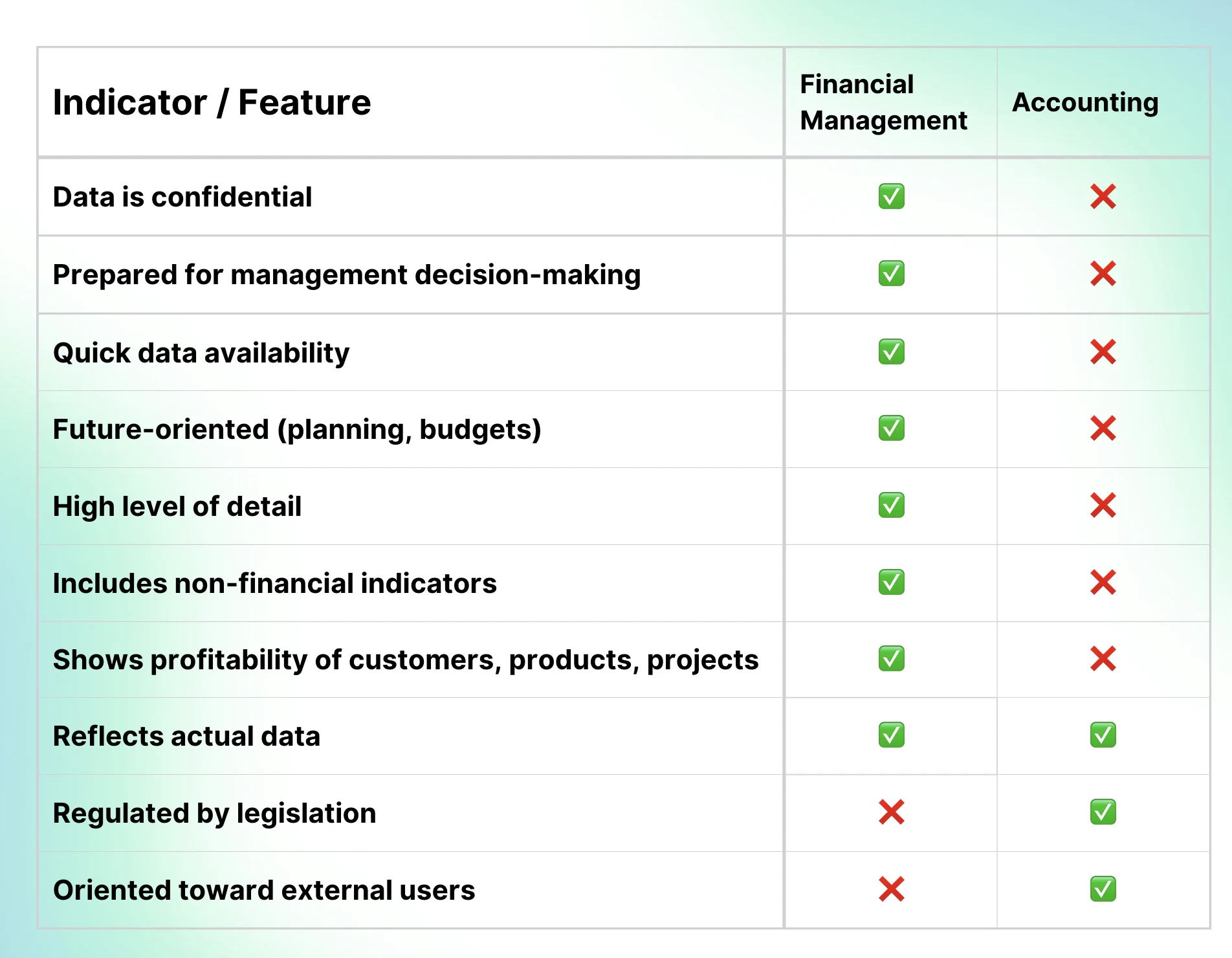
Key distinction:
Accounting answers the question: Is everything correct?
Financial management answers: Is everything profitable?
And if you rely solely on accounting — you’re not getting analytics, you’re just getting a report.
Why Your Accountant Shouldn’t Be the Only One “Responsible for the Numbers”
One of the most common business scenarios is when all financial responsibilities are given to the accountant. Formally, they’re in charge of record keeping and reporting, but in practice they’re also expected to calculate profits, analyze expenses, advise on investments, and prepare budgets.
Business owners get used to having all the numbers in one person's hands, and that’s convenient — but this model has serious limitations.
Accounting and financial management are different processes, requiring different logic, skill sets, and approaches.
Key Tasks of an Accountant
These functions ensure the company's financial transparency to the state:
- Maintain records according to NAS or IFRS.
- Prepare mandatory reports for tax and regulatory authorities.
- Control primary documentation.
- Calculate payroll, taxes, depreciation, and reserves.
- Handle audits, inspections, and work with regulatory bodies.
- Ensure compliance with tax and legal requirements.
Key Tasks of a Financial Management Specialist (CFO, Analyst or Financial Analyst):
These tasks form the basis for effective management of money, profits and the financial future of the business
- Financial planning, budgeting, variance analysis.
- Profitability, cost-effectiveness, and margin analysis.
- Create financial management reports (P&L, Cash Flow, Balance Sheet in internal format).
- Forecast cash flows.
- Build financial models and assess project viability.
- Provide analytics for decision-making.
- Oversee financial strategy implementation.
In companies where only the accountant handles finances — it works only up to a certain level. But this doesn’t diminish the accountant’s role: they do complex, vital, and technical work.
It’s just that their job is about accuracy and compliance, not profitability and strategy.
If you want a true financial picture to manage your business — you need a separate function or expert focused specifically on financial management.
Compliance ≠ Cash Flow Control
Accounting is not designed for owners or for daily business management. Its goal is to ensure legal compliance. That’s why it doesn’t answer key questions owners ask:
- Which business line is the most profitable?
- Where are we losing money?
- What is our breakeven point?
- Which projects should be shut down, and which ones scaled?
- Will we have enough cash for payroll in two weeks?
Why Accounting Doesn’t Give You the Answers You Need
Even if the data in your accounting system is technically correct — it’s often not structured in a way that helps you manage the business. Here are the main issues:
- Reports are delayed — real data may come weeks or months after the fact.
- Data is aggregated, with no breakdown by product line, client, or sales channel.
- Expenses are recorded by accounting logic, not where they actually occurred (e.g., to the warehouse or into the cost of goods sold for the whole business).
- Financial management-specific details (like conditional costs, allocated budgets, internal transfers) are not considered.
.webp)
As a result, owners receive correct but useless information. Everything looks fine on paper, but in reality — cash gaps, unprofitable units, and chaos in decision-making.
See. Calculate. Act: Why Owners Need Financial Management
Financial management is not about formality — it’s the core operational tool for owners and executives. When set up properly, it shows you what’s really happening in your business and helps you make fact-based decisions.
The key problems financial management solves:
- Profitability analysis by product, project, business line
You can see exactly what’s profitable and what’s wasting resources.
- Budgeting and financial planning
Plan income, expenses, profits, and cash flows. Analyze deviations between plan and actuals.
- Liquidity forecasting and cash gap prevention
Financial reports help you know how much cash you’ll have in the future.
- Expense control and business model efficiency
View costs by direction, channel, or product — and cut the waste without touching profits.
- Financial reports for owners or investors
A transparent, structured financial model is the foundation for growth, funding, or selling the business.
- Timely information for decision-making
Reports are prepared weekly or monthly — not quarterly, when it’s too late to change anything.
And although financial management is a conscious leadership choice, some countries legally require entrepreneurs to implement it alongside accounting.
%20(1).webp)
To grow — you must delegate: finances should work for you
If your business is still small, you can start on your own: spreadsheets with income and expenses, manual cost allocations, a simple budget. That’s already better than nothing.
But sooner or later, you’ll hit a wall:
- Your numbers don’t match
- Reports lag behind reality
- You start doubting the data
- It becomes hard to make decisions — because you don’t trust the numbers
Financial management isn’t just a set of files. It’s a system that must be implemented, supported, and scalable.
That’s where experts come in. An experienced financial specialist can:
- Build the right analytical structure
- Set up logic for cost allocation
- Create reports that actually work
- Prepare you for growth or investment
- Help you avoid costly mistakes
Your job is to make decisions. The financial expert’s job is to give you the right numbers. Regularly. Accurately. Without doubt.
So yes, both accounting and financial management matter — because they answer different questions: one ensures legal compliance, the other drives business performance.
It’s your choice: settle for what’s required by law, or implement financial management and finally start running your business based on real numbers!
.webp)
How Finmap Shapes the First Investments Strategy
We tell you how to turn a startup into a successful business and attract investments for stable development with the help of well-established financial management.
Investors do not hand out money just for a good idea. They invest in a vision supported by real financial arguments. An ambitious project, a strong team, and scalability prospects are important, but without a clear financial strategy, there will be no deal.
Can you convincingly explain how the invested funds will turn into profit? If not, the chances of securing investment are nearly zero. Strong financial indicators are not only proof of a business’s viability, but also a demonstration of its readiness to compete in a large market.
How to properly prepare for attracting investments and what really convinces investors – we break it down in this article.
Why Excel Is a Trap for Business and How to Escape It
Every entrepreneur has faced this: chaos in financial management, wasted time, and endless corrections of broken formulas in Excel.
This was also the case for Artem Sitnikov, the founder of SITNIKS CRM – a customer relationship management system designed for small and medium-sized businesses.
He quickly realized that without a clear financial management system, a business cannot survive.
.webp)
Where to Start? Ordering custom Excel spreadsheets. The idea seemed logical, but reality quickly made things clear:
- Constant updates – a waste of time, which is always in short supply.
- Formulas break – one mistake, and reports lose their meaning.
- Inconvenient access – employees could see everything or nothing at all.
- No change control – it was nearly impossible to track who made what changes to the files.
Managing finances in this way was frustrating, time-consuming, and did not bring the expected results.
Artem did not stop there and continued to search for the ideal financial management solution that would meet the following key requirements:
- Reduce and optimize the time spent on financial management.
- Eliminate the need to manually enter data.
- Automate report creation and avoid errors.
- Maintain transparent and efficient reporting for investors.

Automation Without Fear: How Finmap Makes Financial Management Simple and Secure
Before fully switching to Finmap, Artem Sitnikov faced common business concerns:
Should all company accounts be connected? How safe is it?
Transferring financial data is a serious step, and any mistake can be costly. The transition took quite some time, but now Artem strongly advises against being afraid. In reality, there is no risk at all.
Finmap is an aggregator of all transactions.
All operations remain in your banks – Wise, Santander or any other. The service simply collects data from bank statements into a single system to automate calculations and generate accurate reports.
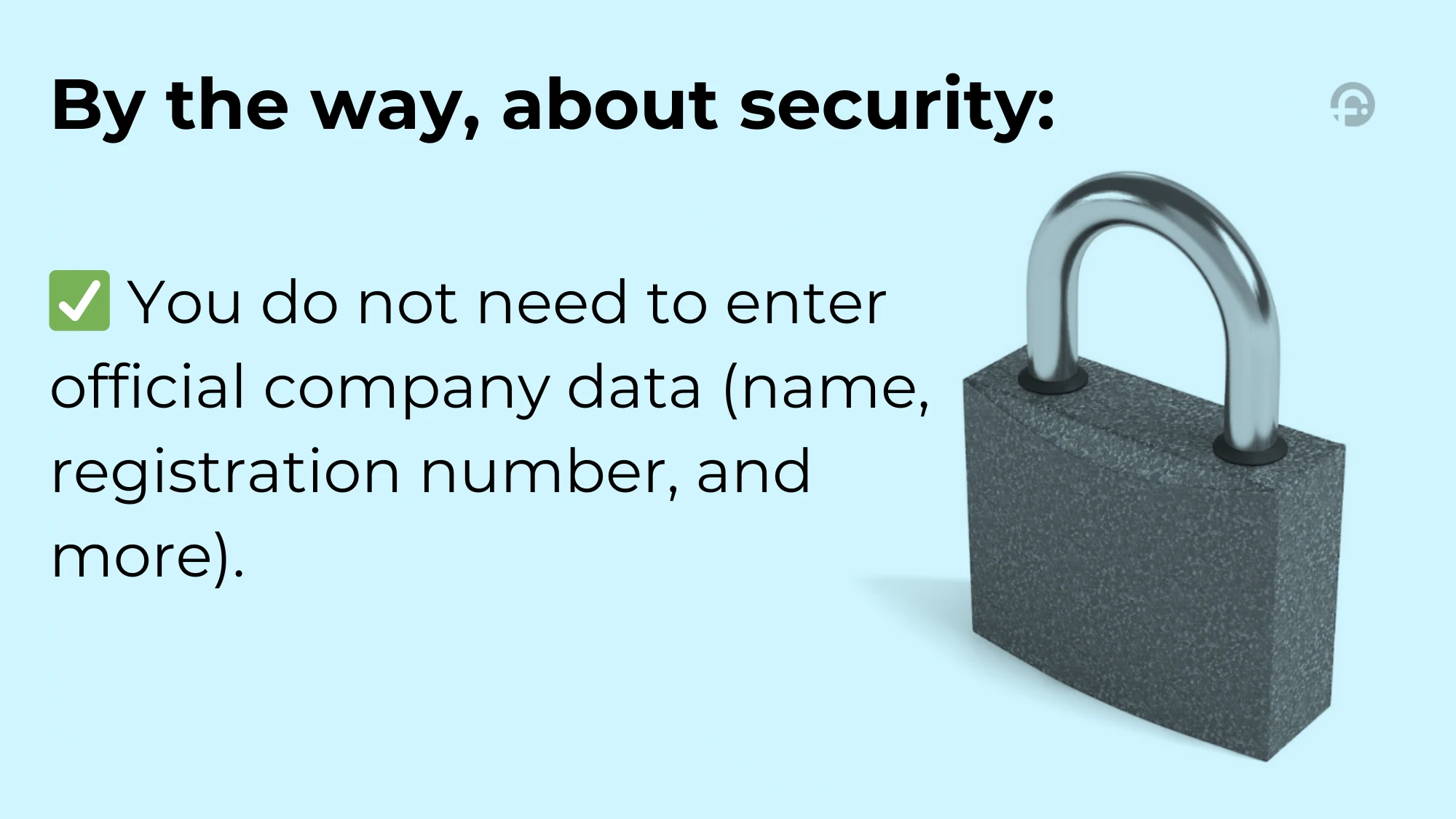
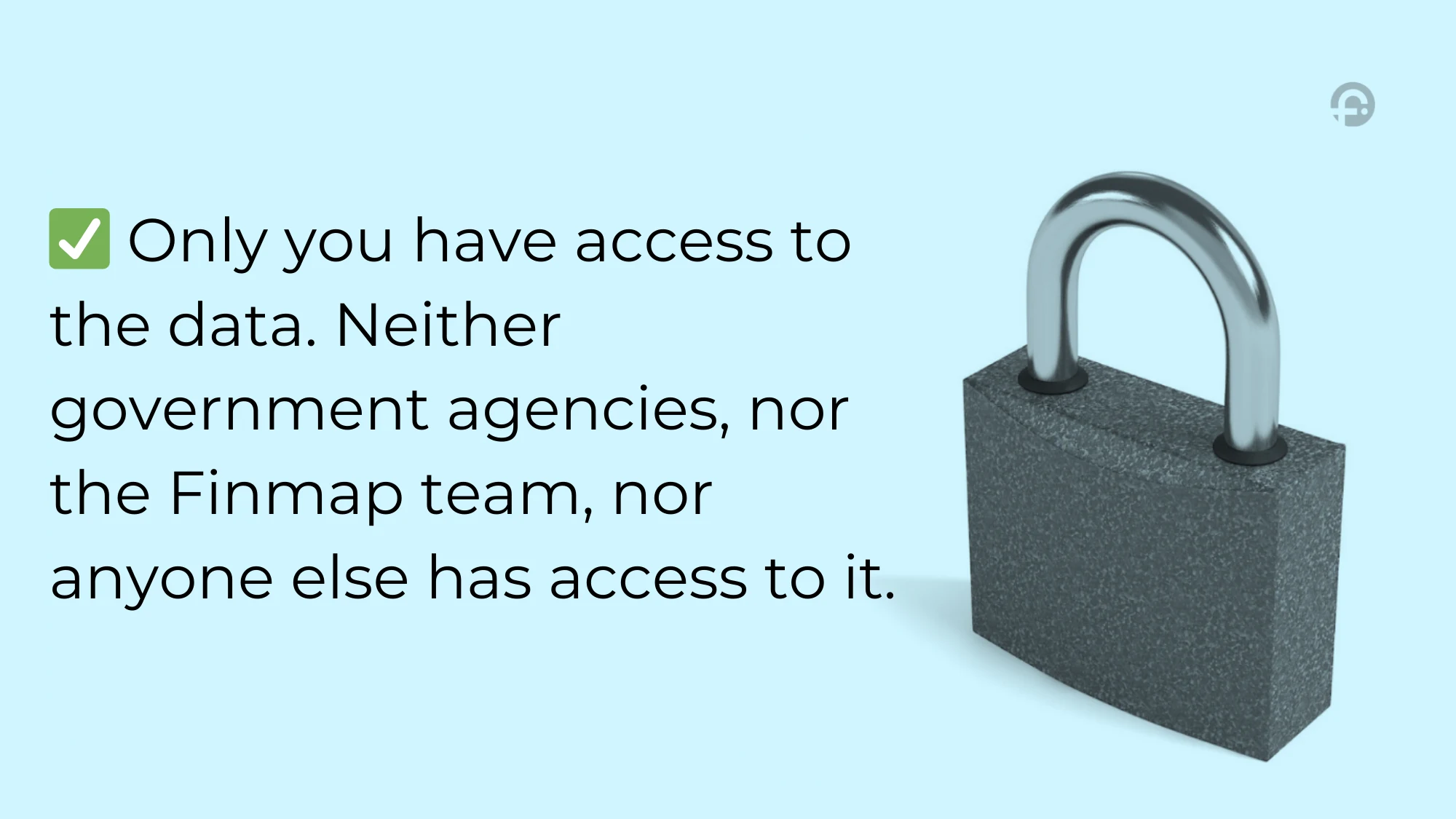
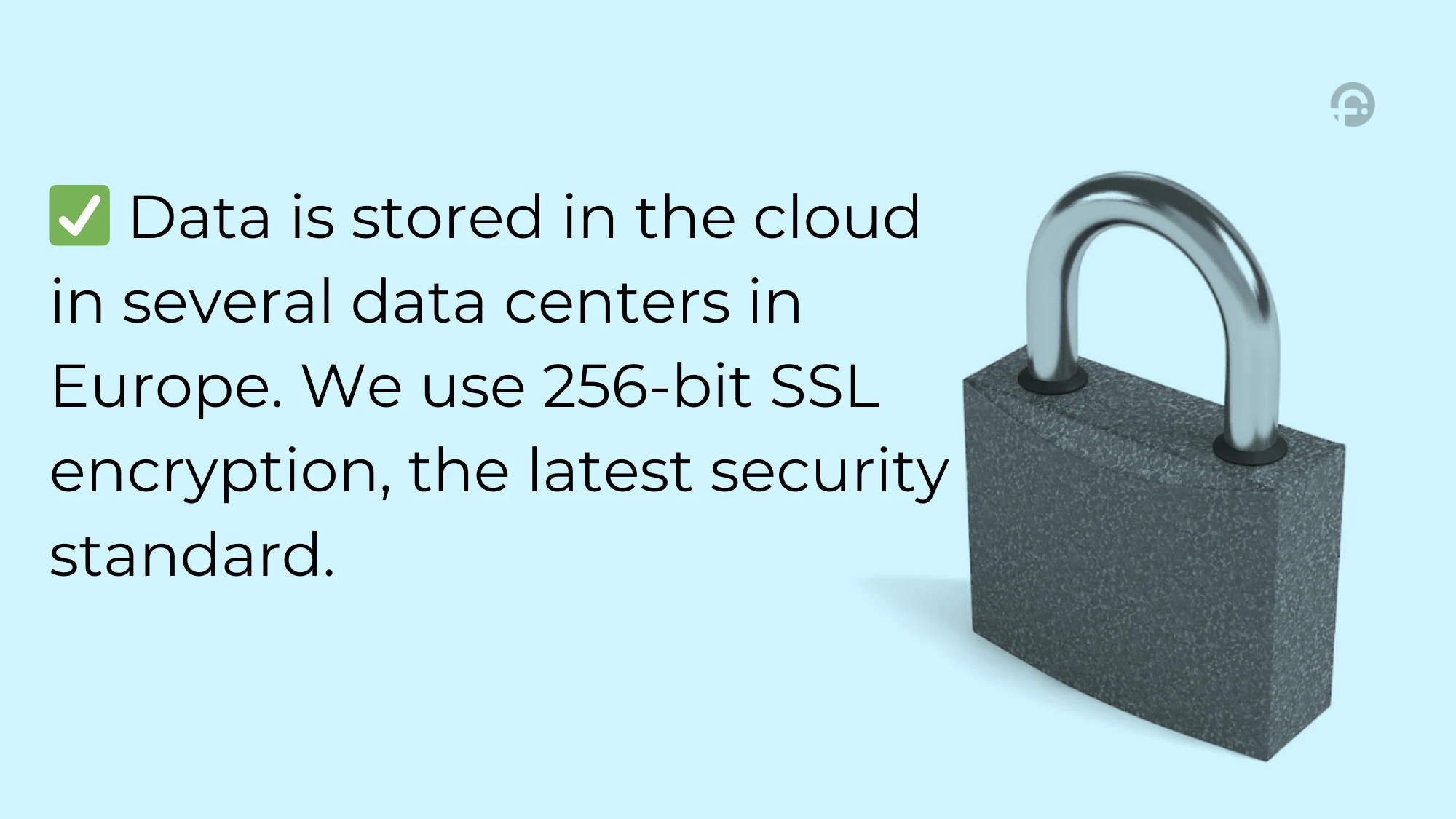
The key factor in choosing Finmap was the P&L report, which Artyom called “Finmap gold”. But let's go through everything in order.
P&L, Cash Flow, and Automation: What Makes a Business Attractive to Investors
Financial routine slows down business growth. Thanks to Finmap, Artem's company eliminated financial gaps, gained a clear financial picture, and created attractive conditions for investors. Here’s how it works in practice:
- The issue of time optimization was resolved through banking and individual integrations, as well as automation rules. With these tools, data entry and processing require only minimal intervention from managers and the owner.
- Using flexible access settings, financial management was easily delegated to employees. As a result, Artem no longer has to dive into daily routines and can instead focus on scaling the business and attracting investments.
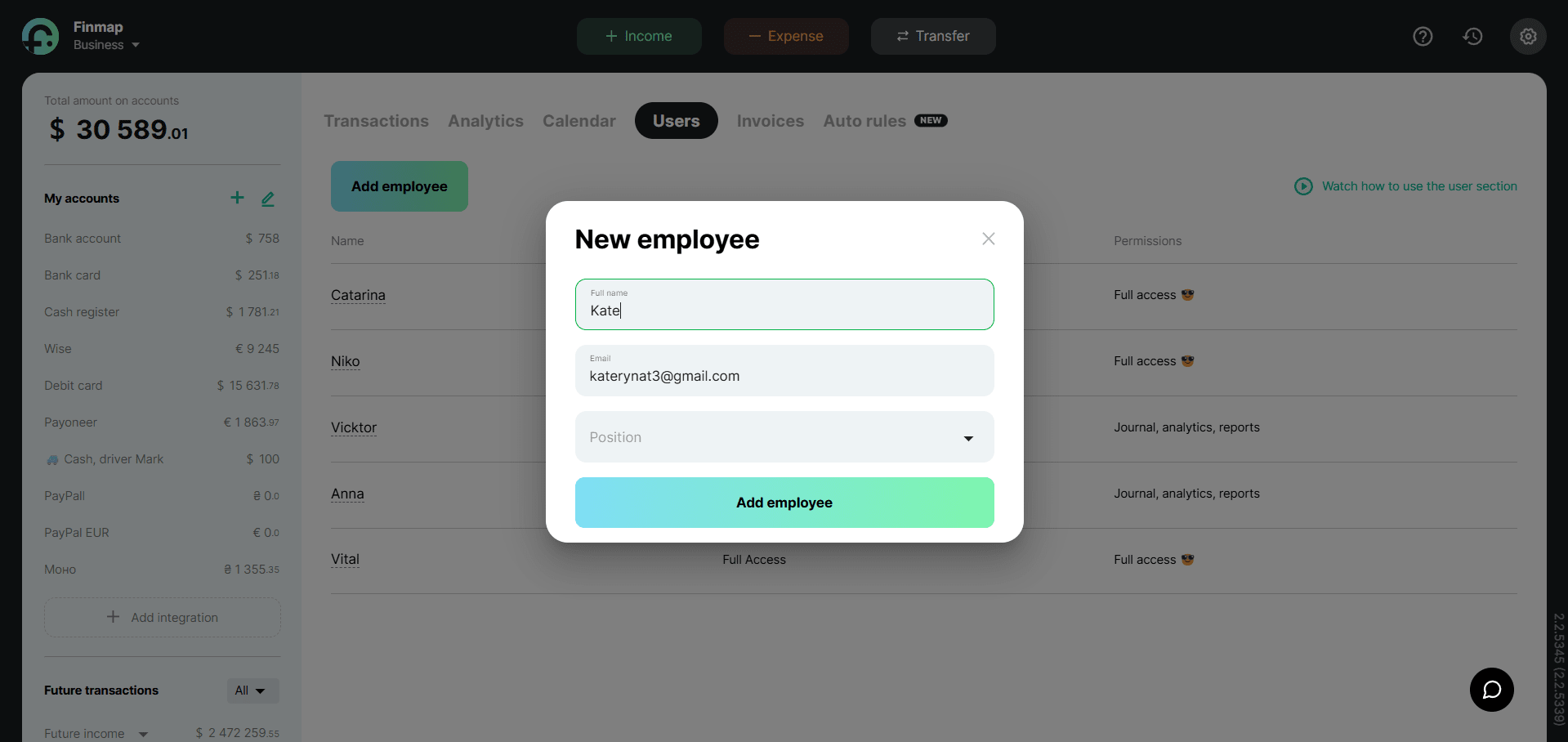
- Potential and existing investors gain full visibility into the company’s financial flows. They can assess its stability, expenses, and future financial obligations at any time. This not only builds trust but also makes the business more attractive for new capital investments.
- By setting up the process of collecting and processing transactions, the Cash Flow report in the company is now generated automatically.
- The Profit and Loss (P&L) report consolidates all data and provides real financial results by category, contractor, and project. A detailed filtering system helps analyze data not only on the overall state of the business but also by individual metrics. At the same time, the report’s interface and content remain simple and easy to understand.
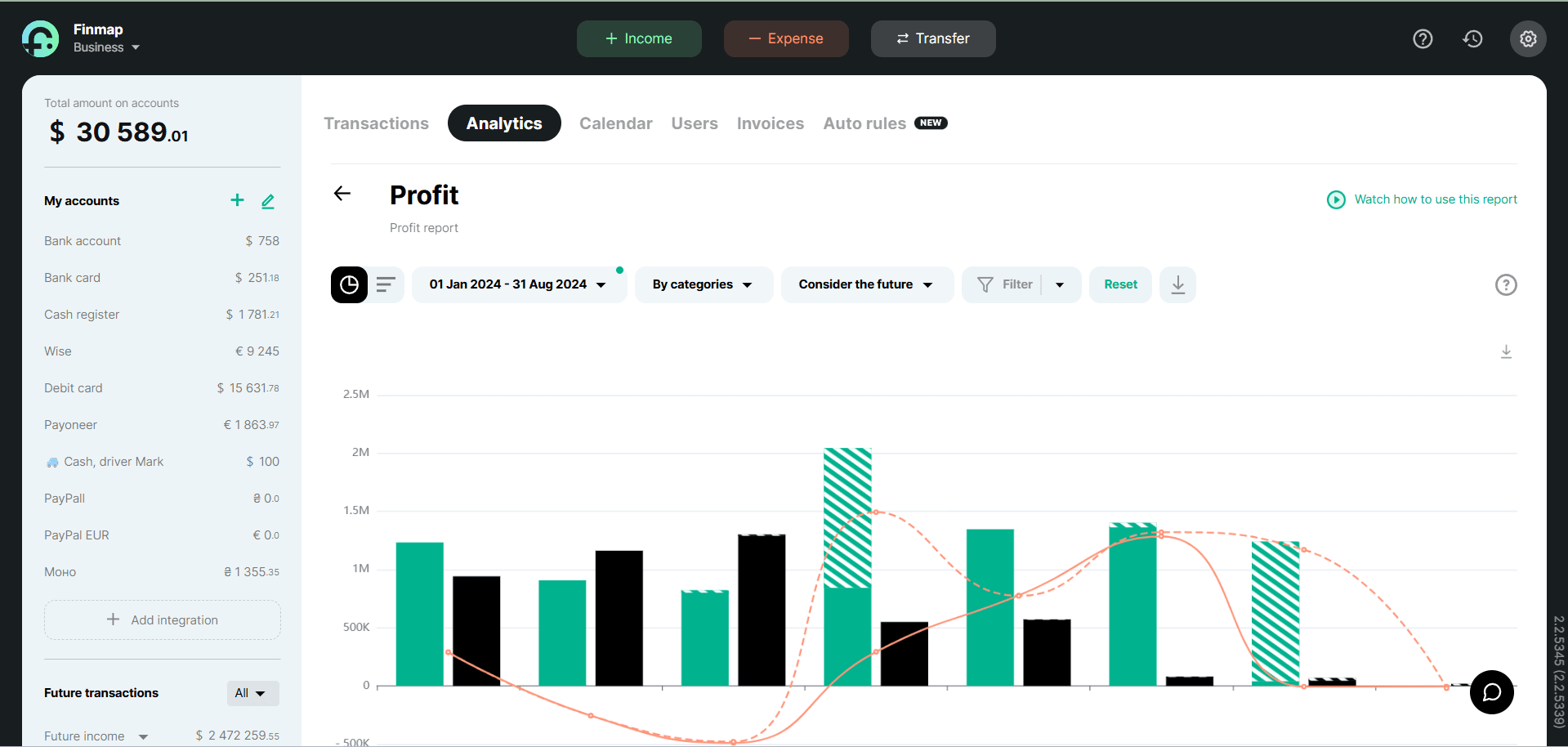
- After solving the key financial issues, Artem focused on another critical aspect: managing accounts receivable – a hidden profit reserve. Using a specialized report in Finmap, the company quickly identified clients who delayed payments in certain months.
The result: Now, funds arrive on time, which positively impacts cash flow and helps avoid cash gaps.
How to Improve Financial Reporting: Tips from Artem
Financial reporting clearly shows where money is going, how stable income is, and whether a business can attract investments. Artem Sitnikov shares key recommendations from his own experience:
- Start using a financial service as early as possible. Time is a resource that should not be wasted. The sooner you start financial management, the faster you can optimize expenses and increase profitability.
- Make financial reporting clear. Investors and partners must clearly see how your business operates and how you plan to use their funds. Transparent finances build trust and simplify capital attraction.
- Analyze financial flows. Using modern tools like Finmap helps maintain organized records, quickly identify problem areas, and make informed decisions.
Artem’s experience proves that adopting modern financial management solutions can turn a startup into a profitable company.
How Finmap Opens the Way to New Heights
The biggest breakthrough after implementing Finmap was that attracting investments became easier, and negotiations with investors became more convincing. Now, financial analytics are more accurate than ever, and potential partners have full access to key business indicators in real time.

Instead of endless spreadsheet exchanges and manual data consolidation – automation and transparent reporting. This is not just saved time and money, but a foundation for growth. Thanks to Finmap, the company has not only optimized processes but also become more attractive for new capital investments.
After implementing Finmap, we attracted our first investment. — Artem Sitnikov, CEO & Co-founder of SITNIKS CRM company
Tools for Your Financial Success
Regardless of your goal – attracting investments, taming financial chaos, forecasting and avoiding cash gaps – all Finmap tools work for you:
- Centralized data storage – all financial data in one system for easy analysis and management.
- Automatic calculations – calculates key financial metrics automatically, reducing time spent on manual calculations and minimizing errors.
- Integration with banks and payment systems – seamless interaction with financial institutions.
- Payment Calendar – ensures forecasting and cash flow planning.
- Cloud storage – guarantees data security and accessibility.
- Automation rules – streamlines routine processes and improves efficiency.
- Flexible access system – custom access levels for different users.
Finmap is not just a financial management tool, but a strategic partner that helps not only organize finances but also unlock new opportunities for investment.
Ready for a financial revolution in your company? Start using Finmap today!

2025 Financial Management: Top 5 Trends to Follow
Effective and insightful financial accounting is only possible when it aligns with current trends and the modern business environment. Let’s take a closer look at the key aspects of financial accounting that will be crucial in 2025.
Most entrepreneurs perceive financial management as a continuous, systematic process of data collection and processing. They assume that once set up, it will operate seamlessly without further adjustments. However, this is a misconception.
Effective financial management is only possible when it aligns with current trends and the modern business landscape. Methods that were effective 3–5 years ago may now only complicate processes and consume additional time.
Are you ready to discover what lies ahead for financial management in 2025? The trends shaping its efficiency could be the key to your business success. Don’t miss the opportunity to implement innovations in time and stay ahead of the competition.
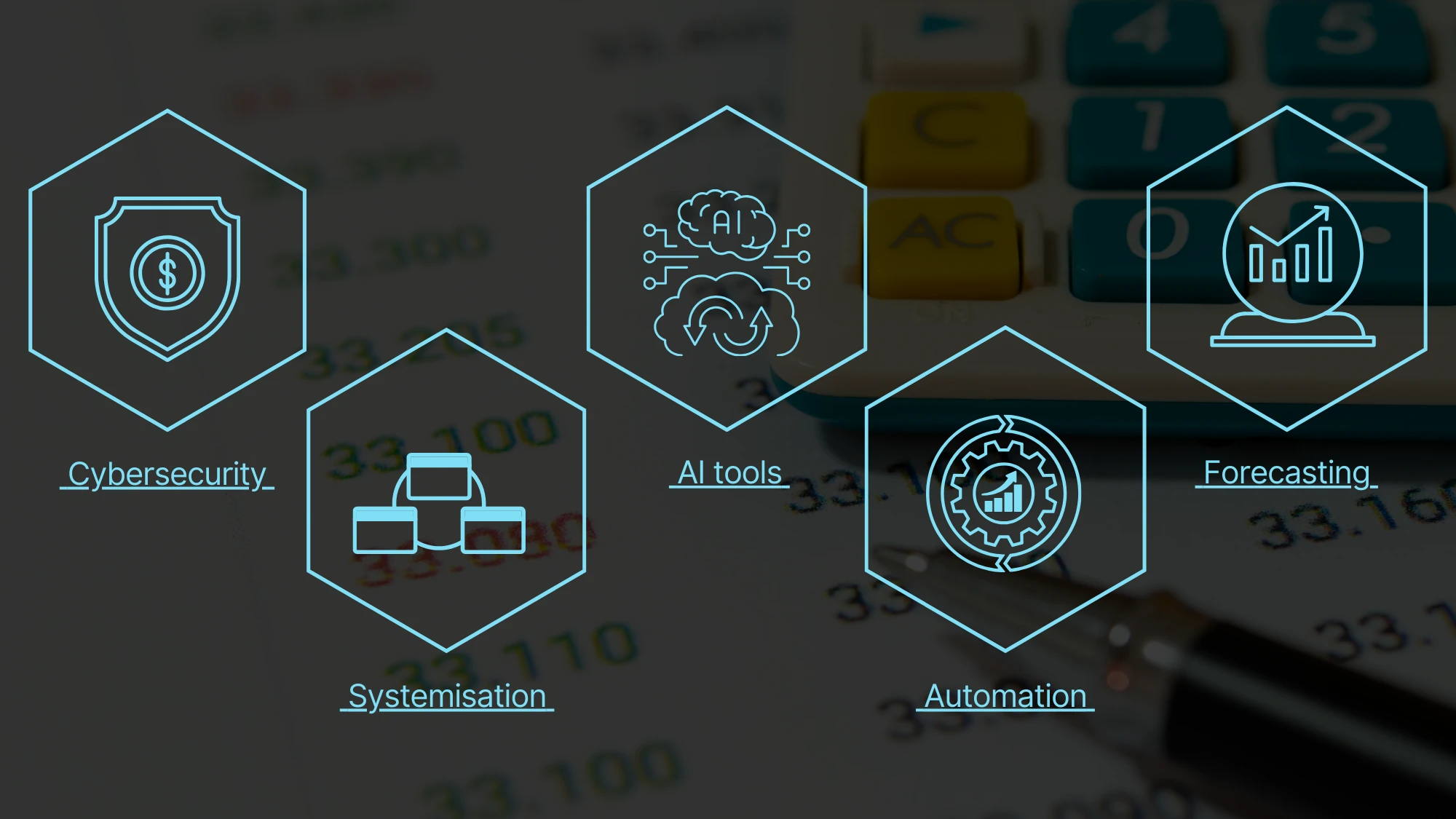
Cybersecurity
The advancement of digital technologies creates new opportunities for businesses but also makes them more vulnerable to cyber threats.
Financial information is one of a company's most critical assets. Protecting data from leaks, attacks, and internal threats must be a top priority.
The rise in cyberattacks worldwide is driven by increasing geopolitical instability and the digitalization of businesses. As a result, the cybersecurity market has expanded, boosting demand for automated solutions with built-in security systems.
In financial management, this translates into the need for:
- Protecting data from unauthorized access.
- Secure storage of financial documents in cloud services.
- Minimizing the risks of data loss or theft of confidential information.

Given the growing cyber threats, companies must combine innovative management solutions with robust data protection mechanisms to mitigate risks and ensure the stability of financial processes.
Systematization
Systematizing financial processes is not just a trend but a strategic necessity.
It involves structuring financial data, implementing clear standards, rules, and procedures that simplify analysis and reporting. This, in turn, enhances the speed and efficiency of managerial decision-making.
A system is what separates a successful business from chaos. — Ray Dalio, Founder of Bridgewater Associates
Systematizing financial management provides businesses with a range of strategic and tactical advantages, as it leads to:
- Increased accuracy of financial information.
- Transparency and control over cash flows.
- Cost optimization and improved profitability.
- Compliance with legal requirements and risk reduction.
- Strengthened financial discipline within the company.
- Readiness for scaling and attracting investors.
Companies that neglect financial systematization are playing financial roulette. Meanwhile, those that implement a structured approach gain control, predictability, and a competitive edge. In an era of rapid change, survival belongs not to the largest but to the most organized.
Process Automation
Financial Management Automation, along with systematization, becomes a key factor in effective financial management. It can be achieved by implementing the following functions:
Integration
Integrating management systems with banking and payment services (Stripe, PayPal, Fondy) enables real-time receipt, processing, and analysis of financial data, ensuring:
- significant time savings on transaction processing;
- minimization of risks associated with human error;
- transparency of financial flows;
Auto Rules
Modern financial management services allow for the creation of automatic payment distribution rules based on categories and other characteristics (for example, all payments with the comment “Payment for (product/service)” are automatically classified under income with the “Sales” category).
Automatic Financial Reporting
Instead of simply using templates or pre-made report formats, opt for programs that will automatically generate the main reports based on the entered data. Prioritize services that allow for the automatic generation of:
- Balance sheet
- Profit and loss statement
- Cash flow statement
- Debt report

Electronic Document Management
The transition to e-document management minimizes paperwork, automates invoice issuance, contract signing, and document exchange with counterparties and tax authorities.
Delegation and Implementation of AI
Continuing the topic of automation, it is important to highlight the involvement of artificial intelligence in the financial management process. Currently, AI should be seen not as a threat to jobs, but as a way to free people from routine tasks.
AI can be implemented in the following areas of management:
- Report Generation and Analysis
Artificial intelligence can process financial transactions and generate reports with analytical conclusions in a structured format. This helps facilitate prompt management decision-making, reduces the workload on staff, and minimizes the risk of human error.
- Forecasting and Risk Management
Algorithms can analyze historical data and market trends, predict future financial indicators, identify potential risks, and recommend strategies for risk mitigation.
- Security and Responsibility Control
This tool can verify transactions for compliance with tax and financial regulations, detect suspicious transactions, and reduce the risks of fraud.
Forecasting
Oleksandr Kravchenko, Managing Partner at McKinsey in Ukraine, advised businesses at the "Ukraine Tomorrow" event to change their approach to activity planning and develop three scenarios: optimistic, pessimistic, and realistic.
Finmap experts recommend creating financial forecasts based on last year's data while considering the aforementioned scenarios. This approach will provide you with a clear action plan and allow you to take informed steps in case of various challenges.
You can’t predict the future, but you can plan for it. — Peter Drucker, management consultant, "The man who invented corporate management"
Thus, financial management in 2025 requires not only accuracy but also adaptability to changes. Companies that implement modern tools for financial management and forecasting will not only optimize their operational processes but also enhance their competitiveness in the business environment.
Are you looking for a solution that meets all the trends of modern financial management? Start working with Finmap — turn numbers into a tool for business scaling and make proactive decisions!

How to Prepare and Analyze Financial Reports for Year-End Results
Let's take a look at how to summarise the financial results of the year, analyse key business indicators and effectively plan for the next financial year.
The beginning of the year is an opportunity to see the true picture of the business based on the results of the past period. What worked best? Where are the hidden reserves for growth? How can you prepare the financial foundation for a successful start to the new year?
In this article, we will explore how to summarize the financial results of the year without missing any important details and how to prepare for planning the upcoming year.

How to Prepare Your Annual Financial Statements Without Any Hassle
Effective financial planning and summarisation helps businesses make informed decisions and avoid mistakes. Follow these tips to make the annual reporting process more accurate and convenient.
- Summarize the annual results at the beginning of January, not at the end of the calendar year. This way, you can collect and systematize all the data related to the past period, even if payments were delayed.
- Implement regular monitoring of the financial situation to minimize the risk of unexpected results at the end of the reporting period.
- Use specialized financial tools throughout the year to collect and store data in a unified system.
Key Metrics for Assessing the Financial Health of a Business
Financial analysis is the foundation of effective business management. To make the right decisions, it is important not just to record income and expenses but also to evaluate key indicators, track their dynamics, and identify patterns.
This will help uncover the strengths and weaknesses of the business, optimize costs, and improve financial results. Let’s explore which indicators should be analyzed and how understanding them can enhance profitability and financial stability of the company.
- Sales Volume in Monetary Terms: This indicator should be analyzed by major product groups, services, and projects, comparing them with previous periods and analyzing the factors that influenced fluctuations.
- Net Cash Flow, according to the Cash Flow report, shows the balance between the company's income and expenses on a monthly basis. Cash flow analysis helps identify periods with a negative balance and the sources to cover it, which is crucial for planning future financial flows.
- Total Business Profit for the Year is a key performance indicator that reflects the overall financial outcome of operations and allows an assessment of the change in results compared to the previous year.
- Profit Dynamics by Month serves as an indicator of business seasonality. If profit shows clear peaks or declines, it allows for adapting the financial strategy, optimizing costs, and adjusting marketing activity.
- Profit by Business Areas – projects, locations, sales points, product/service groups, etc. – helps identify the most profitable products and services, enabling more effective resource allocation and focus on promising directions.
- Margin by Key Areas and Projects reflects how much net profit each area or project generates after accounting for variable costs, which is critically important for strategic business management.


- Share of Key Expenses Relative to Sales allows you to assess the proportion of each expense item, determining their impact on the overall financial result and controlling the dynamics of changes. If the share of key expenses is constantly rising, it signals the need to review the cost strategy, especially if sales are growing more slowly.
- Business Profitability for the Year is a relative profitability indicator used for comparison with market averages. When compared to last year’s data, it provides insight into whether operational efficiency is increasing.
- Financial Position of the Business: Analyzing assets and equity, as well as the ratio of working capital to current liabilities. This is determined based on the management balance sheet and helps to identify changes in the structure of assets and liabilities, as well as assess the company’s ability to meet obligations and the effectiveness of profit utilization.
- Additional key indicators for your business may include: ROI, LTV, MRR, Break-even Point, Unit Economics, etc.
Regularly assessing key indicators allows you to control the financial situation and identify hidden opportunities for growth. A strong business is built not on assumptions, but on accurate data.
Therefore, it is important not just to look at the numbers, but to understand their meaning, learn to forecast risks, and act proactively. Those who systematically analyze their finances achieve stability and a competitive advantage, which ultimately determines the company’s future.
Benefits of Annual Analysis for the Financial Health of the Company
Annual analysis is not only an assessment of the company’s performance but also an important tool for strategic planning, allowing you to:
- Adjust current business processes.
If throughout the year the company faced issues such as a lack of working capital, failure to account for seasonality, or a slowdown in sales, it signals the need for changes.
- Conduct a deep analysis of the company's financial position.
It is important to focus on the ratio of working capital to current liabilities to avoid cash flow gaps. Profitability and margin indicators should be used to assess the effectiveness of resource utilization.
- Make decisions regarding key business areas.
Annual analysis helps identify the most profitable projects and assess the costs of supporting unprofitable ones, as well as their impact on overall financial performance. Based on the report, insights can be gained on alternative monetization strategies or the reformatting of unprofitable assets.
Predefine the break-even point for each business area to keep track of the indicators throughout the year.
- Develop a growth strategy adapted to the real market conditions.
Use the data collected to compare with market averages and adjust the strategy to external changes. Market shifts may require adjustments to pricing policies or product assortments.
How Annual Analysis Helps in Making Strategic Decisions
Assess possible business development scenarios based on financial data and prepare flexible strategies for different economic conditions (growth, recession, changes in demand).
Annual reporting is also one of the key foundations for building a financial model for the business, which in turn helps to find answers to questions such as:
- How to predictably and steadily earn more;
- How to keep the business above the break-even point;
- Is it profitable to open a new business direction;
- How to prevent crisis situations.
Thus, compiling annual reports helps analyze business performance and make informed management decisions regarding future development. It’s important to note that you can quickly obtain accurate annual results only with a well-established systematic accounting process.
Finmap will help organize your finances and become your reliable support in the world of numbers. No more trouble with reporting!

Scaling Business by 300% in a Month: How Finmap Drives Growth During Crisis
Managing several online projects at the same time, Dmitry Frolov found a way to put his finances in order and ensure stable business growth. How did he manage to achieve this with the help of Finmap? Find out in our article.
Launching and developing online schools and online courses is a complex process, especially when it comes to working with several projects at the same time. Dmytro Frolov, the founder of a production center and co-owner of an English language school, faced the need not only to launch new courses efficiently but also to maintain control over finances in the face of rapid business development.
Find out how he managed to put his finances in order and ensure the stability of his projects with the help of Finmap in this article.
Meet: Dmytro Frolov and His Production Center
Dmytro Frolov is an entrepreneur who runs a production center specializing in launching and driving cold traffic to online schools and online courses. He also co-owns an English language school for Ukrainians founded by Kirill Makashov. These business lines pose many financial challenges for Dmytro, which must be addressed for the sustainable development of the projects.

Financial Traps: How Cash Gaps Almost Destroyed Business
Prior to founding the production center, Dmytro ran a marketing agency, but faced two serious cash gaps that negatively impacted his experience and reputation. Previous financial strategies based on manual calculations in Google Spreadsheets and working with old-school accountants were not effective, and Dmitry was tired of continuously trying to control the chaos in his finances.
One of the main mistakes was the perception of the account balance as a financial result of the business, which led to a misunderstanding of the company's real performance.

Thanks to these lessons, the entrepreneur began to study financial literacy and learn how to structure his finances correctly. This experience confirms the importance of proper financial accounting for any business, regardless of its scale. After all, 70% of businesses close due to cash gaps, which can be avoided if you manage your finances properly.
Finmap: From Chaos to Clear Financial Management
Since the launch of the production center, Dmytro and his team have been working with several clients at the same time (from 3 to 5 schools), creating an internal management system. When the English language school appeared, there was a need to build a financial system from scratch.
The growth of the business led to an increase in sales flow, the emergence of accounts receivable and the opening of accounts in different countries, which made it difficult to manage. Then, on the recommendation of a friend, Dmytro decided to turn to Finmap.
Immediately after connecting Finmap, he managed to combine all the accounts into one system and get a complete picture of the business's finances. On the very first day of using the tool, Dmytro saw how much money the company had, which was a real eye-opener.
Finmap made it possible:
- Quick access to financial information. At any time, Dmytro can use his smartphone to view the full picture of his finances, which has greatly simplified his control over the business.
- Automation of complex processes.Thanks to Finmap, salaries and payments to partners are now distributed without any problems.
- Systematizing expenses by categorizing them in a few clicks helps to avoid mistakes in payments.
- Integration of financial instruments. Previously, due to the large number of accounts, there was often a lack of funds to pay for certain services or salaries, as some expenses might not have been taken into account and automatic debits from linked cards or accounts went unnoticed. Thanks to Finmap, Dmytro can now quickly integrate all his accounts and systematize cash flows, which helps him avoid such situations and keep his finances under control.
- Preventing cash gaps. With Finmap, Dmytro can now track account balances and forecast cash flows, which allows him to identify possible cash gaps in advance and take the necessary steps to avoid them.
Why Does an Entrepreneur Need Financial Management from Day One?
Often, entrepreneurs rely on accountants alone, believing that this is enough to manage their finances effectively. However, this is a misconception, as controlling finances is a key responsibility of a business owner.
It's important not only to develop a product or marketing, but also to keep your finger on the pulse of cash flow. — Dmytro Frolov, entrepreneur
Finmap helps to avoid the difficulties associated with manual accounting in Google Spreadsheets. With this system, you can easily control financial flows, including expenses for salaries, taxes, and advertising. This is especially useful for those who have many accounts and currencies.
Initially, the production center had a chaotic financial situation and could not clearly track expenses and income.
As we started to grow, our expenses increased every month, and the number of accounts grew with them. However, it was thanks to Finmap that we were able to integrate all financial flows into one system and get a clear picture of the state of our finances. — Dmytro Frolov, entrepreneur
This allowed him to avoid cash gaps and plan expenses effectively. Financial transparency helped the entrepreneur to control every aspect of the business and make informed decisions.
Why is it Important to Start with the Financial System at the Start of the Project?
Creating a financial system at the start is much easier than trying to implement it when the business has already scaled up. With Finmap, you can track all expenses and income in real time, avoid mistakes, and keep control of your finances.
The biggest mistake that entrepreneurs make is to postpone the implementation of the financial system until later. — Dmytro Frolov, entrepreneur
Advice for Entrepreneurs from Dmytro Frolov
Dmytro recommends creating a reserve fund of 10-20% of revenue to cover salaries, advertising, and contractors during crisis periods. He emphasizes that businesses that had a financial cushion were able to better adapt in times of crisis (pandemic, war), quickly restart their projects or start new ones.
During the COVID-19 pandemic, his business grew by 300% in one month. Then the war created new difficulties, but thanks to migration processes, in particular the increased demand for online education among Ukrainians who went abroad, the business experienced an explosion of growth again. People were looking for opportunities to develop and learn, which led to an increase in the customer base.
Dmytro shared his experience in financial management, highlighting the key mistakes he faced before implementing Finmap.
Top mistakes in financial management:
- Cash gap. Unforeseen expenses or improper cash flow management.
- Chaos in the accounts. A large number of accounts in different systems can lead to a lack of funds for payments or services.
- Unaccounted for costs. Entrepreneurs often forget about small expenses, which can create liquidity problems. In Finmap, all expenses are integrated automatically, allowing you to better control your finances.
- Create chaos in spreadsheets instead of integrating the system in a week. In Finmap, all finances are automatically accounted for and systematized, allowing you to effectively manage cash flow.
Finmap as a Solution for Business Scaling
With the help of Finmap, Dmitry Frolov's production center was able to significantly optimize its finances, avoiding chaos in accounts and cash gaps. Automated processes have allowed the business to focus on scaling and growth, particularly during the pandemic and military challenges.
Finmap has become an indispensable tool for transparent financial management and a reliable partner for businesses seeking to grow without financial barriers.

How Mathema Online School Automated Financial Management Using Finmap
How Finmap helps online schools improve financial control and ensure financial stability, using the example of Mathema's case.
How can an online school build an effective business model and ensure financial stability? This was the question facing Mathema, an online school specializing in teaching math to schoolchildren. Low repeat sales and insufficient control over cash flow were hindering its growth.
How to make financial accounting a tool for strategic decision-making? How to increase the transparency of financial processes and stabilize profits? The answers to these questions were found in the Finmap program, which changed Mathema's approach to financial management. In this article, we'll look at how Finmap implementation helped the school achieve financial sustainability.
Mathema - Personalized Learning to Improve Math Skills
Mathema is an online math school founded in 2021 that specializes in one-on-one tutoring for students in grades 1-11. The school provides personalized learning that helps students improve their knowledge and fill in gaps. As of today, Mathema serves more than 2,000 students and conducts more than 20,000 lessons every month.

Key Tasks and Challenges on the Way to Success
At the beginning of his journey, the company's co-founder Vitaliy Shkil aimed to create a systematic, predictable and stablebusiness. The idea was to find a business model that would ensure repeatability of processes and transparency of results. Working in the field of education has always been interesting, but there was often a problem with adults dropping out of training even after paying for it in full. This created certain difficulties for the business due to the low level of repeat sales and short-term interaction with customers.
The turning point was the realization that education for children is a completely different market. Children cannot stop learning because it is an obligatory part of life for them, just as work is for adults. This creates an opportunity to build long-term relationships with clients, as the learning process lasts for years.

The Requests of the Online Math School Mathema that Needed to be Solved:
- Business scaling. Aiming to expand an online math school by attracting more students, increasing the number of classes and teachers. To do this, it is important to have a clear vision of cash flows while scaling to avoid financial risks, loss of funds, or inefficient use of resources.
- Increase in sales. The need to increase sales, which requires an accurate understanding of how to invest in attracting new customers in a cost-effective manner.
- Transparent financial management. The need for proper accounting of all financial transactions to ensure transparency and control over the business. This includes accounting for student revenue, teacher expenses, marketing, course platform, etc.
I was lucky with my finances, I always listened to smart people, and they all said: control your finances. — Vitalii Shkil, co-founder of Mathema

In his previous online course business, Vitaliy tried to keep financial records, but it was more "reporting for reporting's sake," without a real understanding of its usefulness. It did not help in business management and did not influence important decisions.
Case study When he started Mathema, his approach to finance changed. Vitaliy already had basic knowledge and understood the difference between cash flow and profit and loss (P&L) statements and why it was important. Thanks to this experience, he was able to build a financially stable foundation for the business, which helped in the development and scaling of Mathema.
I was already applying my knowledge of financial accounting to a new business, making it financially healthy from the start. Because I realized that for me, finance is one of the areas from which I can diagnose something in business. — Vitalii Shkil, co-founder of Mathema

The main challenges for the company in the future were scaling and sales growth. As the business became bigger and more complex, there was a need for effective financial management, which became one of the key conditions for further successful development.
To do this, it was decided to use the Finmap financial accounting system , which helps to maintain control over cash flows and ensures stability in the face of business growth.
Why Switched from Excel to Finmap
Initially, Mathema used Excel to keep track of funds. It seemed like a simple and convenient solution, but over time, it became clear that Excel was no longer suitable for a growing business. It only helped to count money, but did not give a complete picture of finances, which made it difficult to work.
5 Reasons to Switch from Excel to Finmap:
- A complete picture of finances. Owners can see all the company's financial flows on one screen, which allows them to better control income and expenses.
- Different levels of access. In Finmap, you can customize roles for employees. For example, managers can see only what is relevant to their work, without having access to company expenses.
- Integration with banks. Finmap synchronizes with bank accounts, so all payments automatically appear in the system. This reduces the risk of mistakes that used to happen with manual accounting. For example, once $250 were lost in Excel and the team spent two hours looking for the error. With Finmap, this no longer happens.
- Transparency of all operations. All transactions are immediately displayed in the system, which makes it easy to track payments and not lose information.
- Reports for analysis.Finmap allows you to see monthly financial dynamics, which helps you make decisions about business development.
I also want to support cool Ukrainian products like Finmap. — Vitalii Shkil, co-founder of Mathema

Results of Cooperation - What Has Changed in Mathema with Finmap
Since March 2021, Mathema has been actively using Finmap for financial management.
Key Results of Cooperation with Finmap:
- Control of the key metric. For an online school, an important indicator is the number of payments for the first lessons. This is the entry point for new students, and further income depends on its stability. With Finmap, owners can quickly track these payments and respond quickly to declines to avoid losing potential sales.
- Monthly analysis of P&L and Cash Flow. Once a month, the owners check the profit and loss (P&L) and cash flow statements in Finmap. This helps to draw conclusions about the state of the business and make plans for the future.
- Daily monitoring of cash flows. Every day, the owners monitor what is happening with the finances. Thanks to this, the company has never fallen into a cash gap. For example, Mathema has a fund to pay teachers, which is formed from subscription fees, and Finmap helps to keep track of these funds, preventing them from being spent on other needs.
- Cost optimization. Finmap allowed us to see the cost structure in detail and compare them. For example, it turned out that the company was paying too high a commission, which was optimized, freeing up additional funds for the budget.

Thanks to Finmap Mathema not only improved its financial management, but also received a tool for strategic planning. This allowed the company to avoid financial difficulties and use resources more efficiently.
The Finmap program has become an integral part of financial management, giving owners full control and confidence in the stable development of their business.
You can get this result for your business too! Try Finmap today and experience how easy it is to manage your finances, optimize costs, and plan for the future with confidence!

